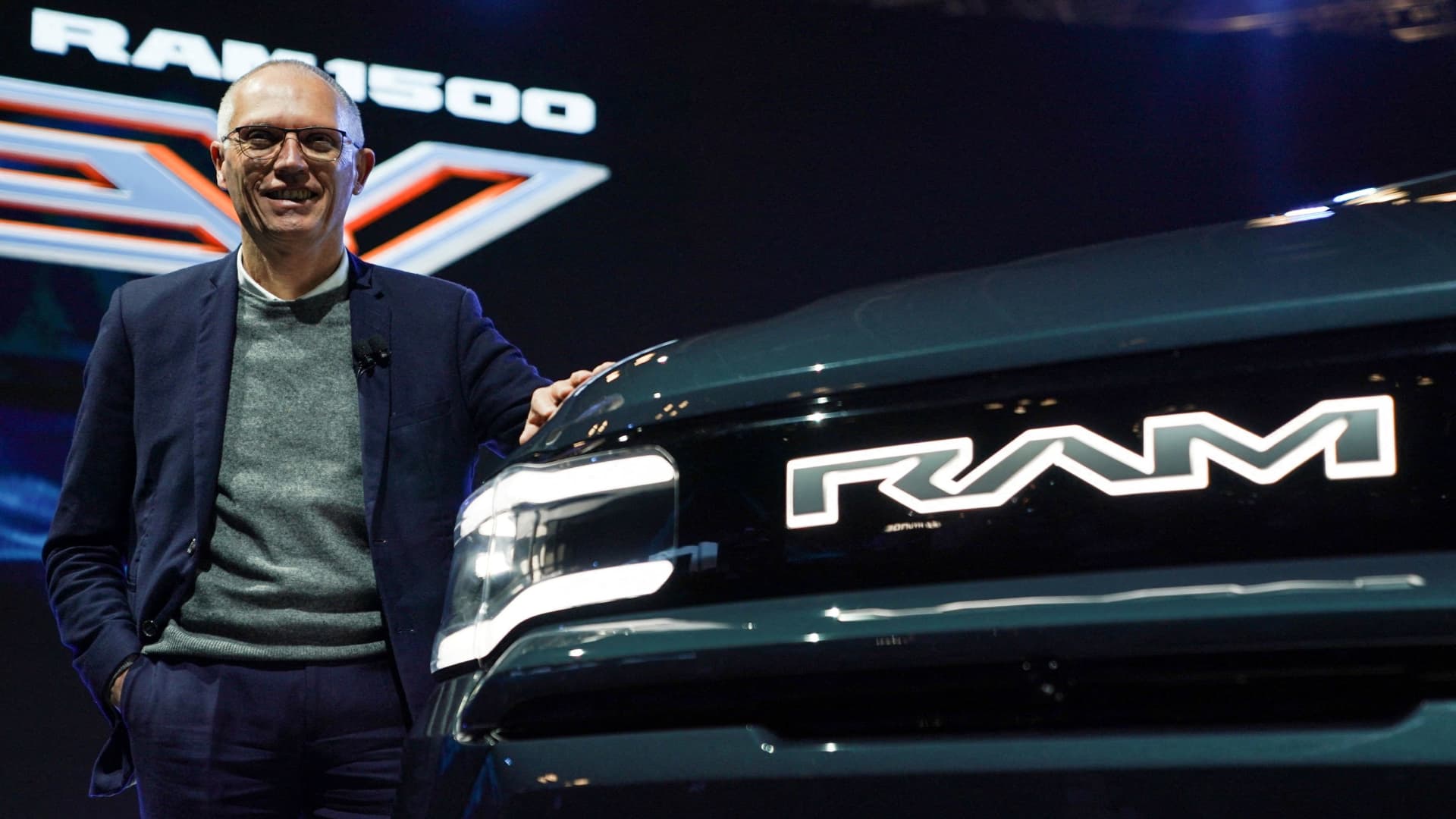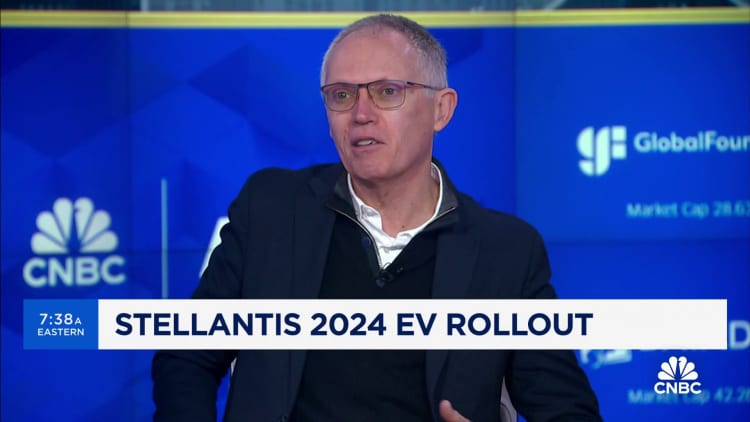Cost cuts, China come into focus

Stellantis CEO Carlos Tavares holds a news conference after meeting with unions, in Turin, Italy, March 31, 2022.
Massimo Pinca | Reuters
DETROIT â Since spearheading a merger to create Stellantis in 2021, CEO Carlos Tavares has been on a cost-cutting mission. That’s beginning to pay dividends for the company and investors.
How the trans-Atlantic automaker expects to keep that momentum amid uncertainty surrounding all-electric vehicles and increasing competition from Chinese automakers is expected to be in focus this week as Tavares leads the automaker’s investor day Thursday.
Tavares and other executive are expected to address Chinese competition, capital discipline, forthcoming products, software initiatives, and potentially, further cost reductions as the company aims to achieve ambitious financial targets by 2030.
When Tavares’ PSA Groupe merged with Fiat Chrysler in January 2021, the freshly combined company set out to reduce spending by 5 billion euros, or about $5.4 billion, annually. It’s a target the company says it will achieve in 2024, a year ahead of schedule.
More recently, Tavares has said the parent of brands like Ram and Jeep needs to remove 40% of its costs to be able to profitably produce and sell EVs to mass-market consumers, citing the need for affordable models despite higher costs to manufacture the vehicles.
“We are not in the race to transition to EVs, but in a race to cut cost on EVs,” Tavares said in late May during a Bernstein investor conference.
The cuts are part of Stellantis’ strategic plan to increase profits and double revenue to 300 billion euros by 2030. The plan also includes targets such as achieving adjusted operating profit of more than 12% and industrial free cash flow of more than 20 billion euros.
The cost-saving measures have included reshaping the company’s supply chain and operations as well as headcount reductions.
Several Stellantis executives described the cuts to CNBC as difficult but effective. Others, who spoke on the condition of anonymity due to potential repercussions, described them as grueling to the point of excessiveness.
Since the merger was agreed to in December 2019, Stellantis has reduced headcount by 15.5%, or roughly 47,500 employees, through 2023, according to public filings. Additional job cuts this year involving thousands of plant workers the U.S. and Italy have drawn the ire of unions in both countries.
Meanwhile the associated billions in operational savings have helped to increase the automaker’s adjusted operating income by 31% from 2021 through last year. Its adjusted profit margin is also up, rising 0.4 percentage point during that time frame to 12.8%.
Stellantis Chief Technology Officer Ned Curic said the company is operating far more efficiently than before, including “proper system engineering” to ensure it’s optimizing design and function for its new vehicles.
Curic, who joined the company from Amazon in 2021, said headcount reductions, including laying off about 400 U.S. engineers in March, come after the company completed many of its systems for the next decade.
“We’ve been cutting headcounts, but we really don’t need that many,” he said during an interview last month, adding the company still employs 50,000 or so engineers. “To engineer the systems for our 10-year road map, it’s already done.”

Tavares, when asked last month whether additional cuts would be needed in the U.S., said “we’ll see.” He said officials “still have work to do” when it comes to getting EVs to be as profitable as traditional internal combustion engine, or ICE, vehicles.
“There is no silver bullet here. You need to throw 40% of additional cost because the middle class in the U.S. as much as the middle class of Europe, they need to buy EVs at the price of ICEs,” he said during a media roundtable in May. “This is no surprise. You can check my comments for the last five years. I’ve been running the same stuff for five years.”
Wall Street expectations
Future cost-saving efforts could be part of the company’s Thursday capital markets day.
Executives on Thursday will outline developments across Stellantis’ regions and businesses, including its capital and operational disciplines, according to Stellantis CFO Natalie Knight.
“We want to help you better understand how we see the industry evolving, how we’re leveraging standout technology, our leading operational discipline, and other competitive advantages that distinguish ourselves further,” she told investors in April. “And how we’re building a powerful and productive capital discipline that help us maintain and maximize sustainable returns.”
Stellantis declined to disclose any specifics ahead of the event, which is taking place at its North American headquarters in Auburn Hills, Michigan.
Carlos Tavares, CEO of Stellantis, poses during a presentation at the New York International Auto Show in Manhattan, New York, on April 5, 2023.
David Dee Delgado | Reuters
Wall Street will be looking for executives to address the company’s growing U.S. vehicle inventory levels, upcoming product launches and plans for China.
At the start of May, Cox Automotive reported days’ supply of vehicles at Stellantis’ Jeep and Ram brands were more than twice the industry average of 76 days.
Meanwhile the threat of cheaper, Chinese-made EVs looms in the background.
Tavares has called Chinese automakers his “No. 1 competitor” and said the company is taking an “asset-light” strategy. That includes plans to quickly grow vehicle exports from the country through a Stellantis-controlled joint venture with China’s Leapmotor.
“The share price reaction to the [capital markets day] will likely be driven by how these short-term concerns are addressed. We don’t expect any new financial targets to be announced,” UBS analyst Patrick Hummel wrote in a Thursday investor note.

Stellantis, GM and Ford shares
Hummel and other analysts have noted a divergence in Stellantis’ stock performance compared with that of General Motors and Ford Motor.
Stellantis’ U.S.-traded shares are down more than 6% this year and off roughly 30% from an all-time high of more than $29.50 per share in March. GM shares in contrast are up more than 30% this year, and Ford shares are essentially flat.
RBC Capital Markets analyst Tom Narayan notes Stellantis, which has a roughly $68 billion market cap, should return 7.7 billion euros to shareholders in 2024 â 4.7 billion euros in dividends and 3 billion euros in buybacks.
Redburn Atlantis analyst Adrian Yanoshik last week in a note said largely muted expectations raise the potential for Stellantis to outperform expectations.
â CNBC’s Michael Bloom contributed to this report.
Read the original article here






